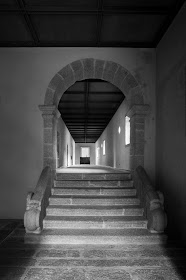A photo gallery, recopied from my Facebook page, from a car trip over the winter holiday through Castilla-León, getting as far as the Cantabrian Sea. Made it to all the provincial capitals except Segovia, Palencia and Soria (hey, it's a big place). Clear skies, chilly but not cold for a clean atmosphere, and low winter sunlight made for spectacular lighting everywhere.
We started with Felipe II's palace monastery of El Escorial. What always
gets me here is the scale, and what happens to people in the plaza. They
are diminished and ennobled at the same time, like actors on a stage
seen from the upper galleries.
 |
| Another detail of the plaza at El Escorial |
Comments:
¡Parece Roma!
¡Pero no esa luz! Y no es travertino blanco sino granito, el más duro de las piedras, ¡aye qué pereza!
 |
| Ávila.... |
 |
| Ávila ! |
The Romanesque basilica of San Vicente in Ávila, 12th century. The upper
part of the left-hand tower is from the 15tth century, my old Blue
Guide says.
 |
| Salamanca: postcard candidate |
s
 |
| Salamanca: general view, with Roman-medieval bridge and busy sky |
 |
| From the riverbank |
 |
| The bridge and Tormes River in Salamanca | | |
Zamora, on the Duero, with the Romanesque cathedral and its fortified
tower. Not too far from the Portuguese border, where the Duero becomes
the Douro and empties into the sea at Porto. We are standing on the
medieval bridge into the city, which fortunately now is pedestrian only.
León,
San Marcos, a former hospice for pilgrims on the Road to Santiago
begun in the 16th century and now a parador, a 5-star state hotel, where
we stayed. You only live once. And it was cheaper than the cheapest
Bowery digs in New York.
The hotel wings were added at the back
by modern architect Fernando Moreno Barberá in the 1960s.
Uncompromisingly modern, like a high-class motor court, the fully-glazed
balconies with beautifully proportioned mullions. Inside, hunt club"
retro furnishings: the curiosities of a Franco-era state hotel (we had a
room in an original wing, overlooking the river).
The building was a notorious Nationalist prison during the Civil War.
León, Plaza de Santa María del Camino. The old town near the cathedral
and Plaza Mayor is moving from marginalization to becoming hip and
gentrified. Still on the way. Spent a good part of the afternoon in this
irregular plaza, paved in cobblestones. Makes the idea of living in
León plausible.

Fishing boats in the port of Lastres, Asturias on the Cantabrian Sea. We
drove from León through the mountain passes that helped protect the
region from Moorish invaders in the 8th century.
More from Lastres:
sd
xx
 |
Why do they do this to the trees in Burgos?
(On the Paseo del Espolón, beside the river Arlanzón) |
 |
| To make them into vaults |
Burgos,
We walked along the river, and then down a narrow lane lined with trees
to the royal Cistercian Monastery of Las Huelgas, founded in 1187 by
Alfonso VII and his English wife, Leonor de Plantagenet (daughter of
Henry II and Eleanor of Aquitaine), and closely associated with the
royal court at Burgos.
"Huelga" means rest, but today it is better known as the word for workers' strikes.
The monastery is for nuns, and has ten rooms for "spiritual retreat". Women only.
On a small secondary road from Lerma to the monastery town of Santo Domingo de Silos

The
monastery of Santo Domingo de Silos, whose famous Romanesque cloister
was built by the Saint himself in the 11th century. Once again we didn't
arrive until it had closed at midday - but that leaves room for another
visit.
The 18th century church, with a Greek cross layout, was
designed by the neo-classicist Ventura Rodríguez, architect of the
fountains of Madrid's Salón del Prado. It replaced a great Romanesque
church.
The monastery is known for its recordings of Gregorian chants and as a place of spiritual retreat for lay people.
From further up the hill we could see the Convento de San Francisco, outside the town walls. 18th century.
The Yeclas gorge, just south of Santo Domingo de Silos. Stumbled upon it
and the walkway through. Result of erosion of soluble rocks, i.e.
karst topography.
On the road back to Madrid, whizzing by red earthen fields in the
falling light, approaching the Sierra de Guadarrama, and the spectacular
sunset, product of suspended particles due to a month-long atmospheric
high (all those blue skies in my photos). The "boina" over Madrid,
pushing against the sierra. Fire in the sky.




































